A Review of Theory and Application Development of Intelligent Operation Methods for Large Public Buildings
Abstract
:1. Introduction
- Primarily based on literature from the past five years, conduct a systematic review of the relevant literature on intelligent operation and maintenance of buildings. Summarize the characteristics of technologies and their applications, providing a clear understanding of the current development status.
- Investigate the current implementation status of intelligent operation and maintenance based on different building sizes and functionalities. Develop an application framework specifically tailored to the intelligent operation and maintenance of large public buildings.
- Summarize the development issues pertaining to intelligent operation and maintenance technologies. From the perspectives of technology, application, and operation, identify the challenges faced by intelligent operation and maintenance. Seek breakthrough opportunities and provide theoretical references for future development.
- Specific focus on building types: Buildings can be classified into various types based on factors such as size and functionality. The maintenance priorities for different types of buildings also vary significantly. This paper specifically investigates and summarizes the development of maintenance practices in large public buildings. It provides a systematic overview of their development process, technological advancements, applications, and outstanding challenges, offering more specific research directions and practical insights for maintenance personnel in large public buildings.
- Timely technological summarization: The literature compiled in this paper primarily includes research outcomes from the past five years. It updates the latest developments in technologies and their applications, ensuring that subsequent research is built upon the most up-to-date achievements.
- Introduction of the B-IRO model: By combining systems theory, this study establishes the B-IRO model, which outlines the technical aspects relevant to the input, interaction, and output stages of building maintenance systems. This model can serve as a foundation for further extensions and research.
- Classification of large public building types: Taking into account building regulations and dimensional characteristics, this study categorizes large public buildings into five types. It provides a specific overview of technological applications for each category, facilitating focused research within subfields.
2. Materials and Methods
2.1. Literature Summarization Method
2.2. System Theory Approach
3. Current Situation and Trends
3.1. The Development of Intelligent Operation and Maintenance
3.2. Article Classification Statistics
3.3. Basic Technology Development
4. Application of Information Technology
4.1. Application Overview
4.2. Intelligent Operation and Maintenance Applications for Buildings of Different Sizes
4.2.1. Low-Rise Buildings Applications
4.2.2. High-Rise Buildings Applications
4.2.3. Super High-Rise Buildings Applications
4.2.4. Underground Space Applications
4.2.5. Traffic Function Building Applications
4.3. Application Value
5. Trends and Challenges
5.1. High Precision Inspection of Building Structures
5.2. The Combination of Human Behavior in Digital Twins
5.3. Improvement of Computing Power
- Hardware solution: There are various building automation systems available on the market, featuring distinct sensors and controllers, which are used for monitoring and controlling various functions of a building [128].
- Controller: The basis of the hardware system is responsible for converting signals from sensors into operable commands and executing tasks related to building automation [129].
- Serial connection: The core of the building automation hardware is the variety of serial connections. The most used ones include RS-232 and RS-485 [130], which provide the means for achieving building automation.
5.4. Human Machine Interaction
5.5. Standardization of Applications
6. Summary and Prospect
- Dynamic monitoring and predictive maintenance: With the accumulation of building maintenance data and advancements in analytical techniques, intelligent systems can utilize machine learning and predictive modeling to forecast potential failures or maintenance needs. This proactive approach can optimize maintenance schedules, reduce downtime, and enhance overall building performance.
- Enhanced energy management: Smart building operations and maintenance can contribute to energy-saving initiatives by optimizing energy consumption and reducing waste. By integrating smart meters, energy management systems, and data analytics, buildings can dynamically adjust energy usage based on occupancy patterns, weather conditions, and other relevant factors. This approach can result in significant energy savings and environmental benefits.
- Automation and robotics technology: Automation technology, including robotics and autonomous systems, can completely change the maintenance process. Robots can perform routine inspections, cleaning tasks, and even minor repairs, reducing the need for manual intervention. This automation not only improves efficiency, but also improves safety by minimizing human exposure to hazardous environments.
- Application of digital twin technology: By combining building information modeling (BIM) with sensors, algorithms, and other technologies, digital twins of buildings can be created. This enables the integration and visualization of various building data, facilitating better collaboration and decision-making throughout the building lifecycle. Digital twins make the complex processes of building operations and maintenance more intuitive and interactive.
Author Contributions
Funding
Institutional Review Board Statement
Informed Consent Statement
Data Availability Statement
Conflicts of Interest
References
- Zhu, J.H.; Li, D.Y. Current Situation of Energy Consumption and Energy Saving Analysis of Large Public Building. In Proceedings of the 9th International Symposium on Heating Ventilation and Air Conditioning ISHVAC Joint with the 3rd International Conference on Building Energy and Environment COBEE, Tianjin, China, 12–15 July 2015; pp. 1208–1214. [Google Scholar]
- Fang, T.C.; Zhao, Y.M.; Gong, J.; Wang, F.L.; Yang, J. Investigation on Maintenance Technology of Large-Scale Public Venues Based on BIM Technology. Sustainability 2021, 13, 7937. [Google Scholar] [CrossRef]
- Raouf, A.; Kettunen, O.V. Developing Apartment Maintenance Systems as Urban Operations. Kybernetes 1978, 7, 131–140. [Google Scholar] [CrossRef]
- Motawa, I.; Almarshad, A. A knowledge-based BIM system for building maintenance. Autom. Constr. 2013, 29, 173–182. [Google Scholar] [CrossRef]
- Barker, O. Realizing the Promise of the Internet of Things in Smart Buildings. Computer 2020, 53, 76–79. [Google Scholar] [CrossRef]
- Jung, J.U.; Jin, K.H. Case Studies for the Establishment of the Optimized Smart Factory with Small and Medium-Sized Enterprises. In Proceedings of the 2nd International Symposium on Computer Science and Intelligent Control (ISCSIC), Stockholm, Sweden, 21–23 September 2018. [Google Scholar]
- Zhou, Y.; Li, L.Y. The 5G communication technology-oriented intelligent building system planning and design. Comput. Commun. 2020, 160, 402–410. [Google Scholar] [CrossRef]
- Minoli, D.; Occhiogrosso, B. Practical Aspects for the Integration of 5G Networks and IoT Applications in Smart Cities Environments. Wirel. Commun. Mob. Comput. 2019, 2019, 5710834. [Google Scholar] [CrossRef] [Green Version]
- Pukite, I.; Geipele, I. Different Approaches to Building Management and Maintenance Meaning Explanation. In Proceedings of the 12th International Conference on Modern Building Materials, Structures and Techniques (MBMST), Vilnius, Lithuania, 26–27 May 2016; pp. 905–912. [Google Scholar]
- Batov, E.I. The distinctive features of “smart” buildings. In Proceedings of the 24th Russian-Polish-Slovak Seminar on Theoretical Foundation of Civil Engineering, Samara, Russia, 24–28 August 2015; pp. 103–107. [Google Scholar]
- Jia, M.D.; Komeily, A.; Wang, Y.R.; Srinivasan, R.S. Adopting Internet of Things for the development of smart buildings: A review of enabling technologies and applications. Autom. Constr. 2019, 101, 111–126. [Google Scholar] [CrossRef]
- Arthur, S.; Li, H.J.; Lark, R. The Emulation and Simulation of Internet of Things Devices for Building Information Modelling (BIM). In Proceedings of the 25th Workshop of the European-Group-for-Intelligent-Computing-in-Engineering (EG-ICE), Lausanne, Switzerland, 10–13 June 2018; pp. 325–338. [Google Scholar]
- Volk, R.; Stengel, J.; Schultmann, F. Building Information Modeling (BIM) for existing buildings—Literature review and future needs. Autom. Constr. 2014, 38, 109–127. [Google Scholar] [CrossRef] [Green Version]
- Lilis, G.; Conus, G.; Asadi, N.; Kayal, M. Towards the next generation of intelligent building: An assessment study of current automation and future IoT based systems with a proposal for transitional design. Sustain. Cities Soc. 2017, 28, 473–481. [Google Scholar] [CrossRef]
- Coupry, C.; Noblecourt, S.; Richard, P.; Baudry, D.; Bigaud, D. BIM-Based Digital Twin and XR Devices to Improve Maintenance Procedures in Smart Buildings: A Literature Review. Appl. Sci. 2021, 11, 6810. [Google Scholar] [CrossRef]
- Mourtzis, D.; Zogopoulos, V.; Vlachou, E. Augmented Reality Application to Support Remote Maintenance as a Service in the Robotics Industry. Procedia CIRP 2017, 63, 46–51. [Google Scholar] [CrossRef]
- Nederveen, G.; Tolman, F.P. Modelling multiple views on buildings. Autom. Constr. 1992, 1, 215–224. [Google Scholar] [CrossRef]
- Ye, X.; Tiecheng, G. The Influence of IBM “Smarter Planet”on China. Forum Sci. Technol. China 2014, 215, 148–153. [Google Scholar] [CrossRef]
- Liu, Y.; Yin, J.Z.; Xu, J.J.; Wang, F.X. Development of New Green, Intelligent Computer Room Environment Monitoring System. Instrum. Tech. Sens. 2010, 329, 41–43. [Google Scholar]
- Hanai, M.; Kojima, H.; Hayakawa, N.; Shinoda, K.; Okubo, H. Integration of Asset Management and Smart Grid with Intelligent Grid Management System. IEEE Trns. Dielectr. Electr. Insul. 2013, 20, 2195–2202. [Google Scholar] [CrossRef]
- He, W. Design and Implementation of Base Station Operation and Maintenance Management System Based on Wireless Content Networking. Coal Technol. 2011, 30, 165–167. [Google Scholar]
- Martinez-Aires, M.D.; Lopez-Alonso, M.; Martinez-Rojas, M. Building information modeling and safety management: A systematic review. Saf. Sci. 2018, 101, 11–18. [Google Scholar] [CrossRef]
- Sun, C.S.; Che, Q. BIM-based Real-time Monitoring of the Equipment Maintenance of Property. In Proceedings of the International Conference on Vibration, Structural Engineering and Measurement (ICVSEM2012), Shanghai, China, 19–21 October 2012; pp. 2217–2221. [Google Scholar]
- Nakama, Y.; Onishi, Y.; Iki, K. Development of Building Information Management System with Data Collecting Functions Based on IoT Technology. In Proceedings of the 33rd International Conference on Education and Research in Computer Aided Architectural Design in Europe (eCAADe), TU Wien, Vienna, Austria, 16–18 September 2015; pp. 647–655. [Google Scholar]
- Che-Ghani, N.Z.; Myeda, N.E.; Ali, A.S. Operations and Maintenance Cost for Stratified Buildings: A Critical Review. In Proceedings of the 4th International Building Control Conference (IBCC), Kuala Lumpur, Malaysia, 7–8 March 2016. [Google Scholar]
- Davtalab, O. Benefits of Real-Time Data Driven BIM for FM Departments in Operations Control and Maintenance. In Proceedings of the ASCE International Workshop on Computing in Civil Engineering (IWCCE), Seattle, WA, USA, 25–27 June 2017; pp. 202–210. [Google Scholar]
- Deng, M.; Menassa, C.C.; Kamat, V.R. From BIM to digital twins: A systematic review of the evolution of intelligent building representations in the AEC-FM industry. J. Inf. Technol. Constr. 2021, 26, 58–83. [Google Scholar] [CrossRef]
- Fei, T.; Meng, Z.; Jiangfeng, C.; Qinglin, Q. Digital twin workshop: A new paradigm for future workshop. Comput. Integr. Manuf. Syst. 2017, 23, 1–9. [Google Scholar] [CrossRef]
- Wei-jia, L.; Bo-quan, L. Application Research on Internet of Things, Big Data Analysis and Machine Learning Technology in Backup for Disaster Recovery. Microelectron. Comput. 2018, 35, 55–58. [Google Scholar] [CrossRef]
- Zhansheng, L.; Anshan, Z.; Wensi, W.; Jingjing, W. Dynamic Fire Evacuation Guidance Method for Winter Olympic Venues Based on Digital Twin-Driven Model. J. Tongji Univ. 2020, 48, 962–971. [Google Scholar]
- Yang, C.S.; Shen, W.M.; Gunay, B.; Shi, Z.X. Toward Machine Learning-based Prognostics for Heating Ventilation and Air-Conditioning Systems. In Proceedings of the ASHRAE Winter Conference, Atlanta, GA, USA, 12–16 January 2019; pp. 106–115. [Google Scholar]
- Bouabdallaoui, Y.; Lafhaj, Z.; Yim, P.; Ducoulombier, L.; Bennadji, B. Predictive Maintenance in Building Facilities: A Machine Learning-Based Approach. Sensors 2021, 21, 1044. [Google Scholar] [CrossRef]
- Mares, J.J.; Navarro, L.; Christian, G.; Pardo, M. A Methodology for Energy Load Profile Forecasting Based on Intelligent Clustering and Smoothing Techniques. Energies 2020, 13, 4040. [Google Scholar] [CrossRef]
- Yoon, S.H.; Ahn, J. Comparative Analysis of Energy Use and Human Comfort by an Intelligent Control Model at the Change of Season. Energies 2020, 13, 6023. [Google Scholar] [CrossRef]
- Correa-Jullian, C.; Droguett, E.L.; Cardemil, J.M. Operation scheduling in a solar thermal system: A reinforcement learning-based framework. Appl. Energy 2020, 268, 114943. [Google Scholar] [CrossRef]
- Xiang, X.Z.; Zhang, Y.Q.; El Saddik, A. Pavement crack detection network based on pyramid structure and attention mechanism. IET Image Process. 2020, 14, 1580–1586. [Google Scholar] [CrossRef]
- Qu, C.F.; Wang, D.L.; Liu, W.X.; Zhao, P.C. Design and Implementation of an Intelligent Operation and Maintenance Management Cloud Platform for Green Buildings Group. In Proceedings of the 5th International Conference on Electrical Engineering, Control and Robotics (EECR), Guangzhou, China, 12–14 January 2019. [Google Scholar]
- Hu, Z.Z.; Tian, P.L.; Li, S.W.; Zhang, J.P. BIM-based integrated delivery technologies for intelligent MEP management in the operation and maintenance phase. Adv. Eng. Softw. 2018, 115, 1–16. [Google Scholar] [CrossRef]
- Peng, Y.; Zhang, M.; Yu, F.Q.; Xu, J.L.; Gao, S. Digital Twin Hospital Buildings: An Exemplary Case Study through Continuous Lifecycle Integration. Adv. Civ. Eng. 2020, 2020, 8846667. [Google Scholar] [CrossRef]
- Du, J.; Zhu, Q.; Shi, Y.M.; Wang, Q.; Lin, Y.Z.; Zhao, D. Cognition Digital Twins for Personalized Information Systems of Smart Cities: Proof of Concept. J. Manag. Eng. 2020, 36, 04019052. [Google Scholar] [CrossRef]
- Hossain, M.A.; Abbott, E.L.S.; Chua, D.K.H.; Qui, N.T.; Goh, Y.M. Design-for-Safety knowledge library for BIM-integrated safety risk reviews. Autom. Constr. 2018, 94, 290–302. [Google Scholar] [CrossRef]
- Sun, G.D.; Yang, G.X.; Guo, B.B. CoCoMo: Toward controllable and reliable corrosion monitoring with a wireless sensor network. Int. J. Distrib. Sens. Netw. 2017, 13, 1550147717734525. [Google Scholar] [CrossRef] [Green Version]
- Yan, B.; Hao, F.; Meng, X. When artificial intelligence meets building energy efficiency, a review focusing on zero energy building. Artif. Intell. Rev. 2021, 54, 2193–2220. [Google Scholar] [CrossRef]
- Zhang, L.; Wen, J.; Li, Y.F.; Chen, J.L.; Ye, Y.Y.; Fu, Y.Y.; Livingood, W. A review of machine learning in building load prediction. Appl. Energy 2021, 285, 116452. [Google Scholar] [CrossRef]
- Wang, Z.Y.; Liu, J.; Zhang, Y.X.; Yuan, H.P.; Zhang, R.X.; Srinivasan, R.S. Practical issues in implementing machine-learning models for building energy efficiency: Moving beyond obstacles. Renew. Sustain. Energy Rev. 2021, 143, 110929. [Google Scholar] [CrossRef]
- Han, B.; Leite, F. Generic extended reality and integrated development for visualization applications in architecture, engineering, and construction. Autom. Constr. 2022, 140, 104329. [Google Scholar] [CrossRef]
- Hu, F.H.; Deng, Y.S.; Zhou, H.; Jung, T.H.; Chae, C.B.; Aghvami, A.H. A Vision of an XR-Aided Teleoperation System toward 5G/B5G. IEEE Commun. Mag. 2021, 59, 34–40. [Google Scholar] [CrossRef]
- Felbrich, B.; Menges, A.; Jahn, G.; Newnham, C. Self-Organizing Maps for Intuitive Gesture-Based Geometric Modelling in Augmented Reality. In Proceedings of the 1st IEEE International Conference on Artificial Intelligence and Virtual Reality (AIVR), Taichung, Taiwan, 10–12 December 2018; pp. 61–67. [Google Scholar]
- Sydora, C.; Stroulia, E. Augmented Reality on Building Information Models. In Proceedings of the 9th International Conference on Information, Intelligence, Systems and Applications (IISA), Zakynthos, Greece, 23–25 July 2018; pp. 282–285. [Google Scholar]
- Wiesner, C.A.; Klinker, G. Overcoming Location Inaccuracies in Augmented Reality Navigation. In Proceedings of the 4th International Conference on Augmented Reality, Virtual Reality, and Computer Graphics (SALENTO AVR), Ugento, Italy, 12–15 June 2017; pp. 377–388. [Google Scholar]
- Badouch, A.; Krit, S.D.; Kabrane, M.; Karimi, K.; Comp, M. Augmented Reality services implemented within Smart Cities, based on an Internet of Things Infrastructure, Concepts and Challenges: An overview. In Proceedings of the 4th International Conference on Engineering and MIS (ICEMIS), Istanbul, Turkey, 19–21 June 2018. [Google Scholar]
- Imbert, N.; Vignat, F.; Kaewrat, C.; Boonbrahm, P. Adding Physical Properties to 3D Models in Augmented Reality for Realistic Interactions Experiments. In Proceedings of the International Conference on Virtual and Augmented Reality in Education (VARE), Puerto de la Cruz, Spain, 7–9 November 2013; pp. 364–369. [Google Scholar]
- Qiao, X.Q.; Ren, P.; Nan, G.S.; Liu, L.; Dustdar, S.; Chen, J.L. Mobile Web Augmented Reality in 5G and Beyond: Challenges, Opportunities, and Future Directions. China Commun. 2019, 16, 141–154. [Google Scholar] [CrossRef]
- Plecher, D.A.; Wandinger, M.; Klinker, G. Mixed Reality for Cultural Heritage. In Proceedings of the 26th IEEE Conference on Virtual Reality and 3D User Interfaces (VR), Osaka, Japan, 23–27 March 2019; pp. 1618–1622. [Google Scholar]
- Li, M.; Li, L.; Jiao, R.; Xiao, H. Virtrul Reality and Artificial Intelligence Support Future Training Development. In Proceedings of the Chinese Automation Congress (CAC), Jinan, China, 20–22 October 2017. [Google Scholar]
- Nguyen, T.B.; Tran, A.B.; Phan, H.T.; Do, Q.H.; Nguyen, Q.T. Exploitation of Digital Data from Building Information Models in Virtual Reality Technology. In Proceedings of the 6th International Conference on Geotechnics, Civil Engineering and Structures (CIGOS), Hanoi, Vietnam, 28–29 October 2021; pp. 1833–1840. [Google Scholar]
- Koeva, M.; Luleva, M.; Maldjanski, P. Integrating Spherical Panoramas and Maps for Visualization of Cultural Heritage Objects Using Virtual Reality Technology. Sensors 2017, 17, 829. [Google Scholar] [CrossRef] [Green Version]
- Lv, Z.H. Virtual reality in the context of Internet of Things. Neural Comput. Appl. 2020, 32, 9593–9602. [Google Scholar] [CrossRef]
- Chen, G.S.; Chen, J.P. Applying Virtual Reality to Remote Control of Mobile Robot. In Proceedings of the 2nd International Conference on Intelligent Technologies and Engineering Systems (ICITES), Kaohsiung, Taiwan, 12–14 December 2013; pp. 383–390. [Google Scholar]
- Erol-Kantarci, M.; Sukhmani, S. Caching and Computing at the Edge for Mobile Augmented Reality and Virtual Reality (AR/VR) in 5G. In Proceedings of the 9th EAI International Conference on Ad Hoc Networks (AdHocNets), Niagara Falls, ON, Canada, 28–29 September 2017; pp. 169–177. [Google Scholar]
- Esenogho, E.; Djouani, K.; Kurien, A.M. Integrating Artificial Intelligence Internet of Things and 5G for Next-Generation Smartgrid: A Survey of Trends Challenges and Prospect. IEEE Access 2022, 10, 4794–4831. [Google Scholar] [CrossRef]
- Mohammed, B.H.; Sallehudin, H.; Mohamed, S.A.; Satar, N.S.M.; Bin Hussain, A.H. Internet of Things-Building Information Modeling Integration: Attacks, Challenges, and Countermeasures. IEEE Access 2022, 10, 74508–74522. [Google Scholar] [CrossRef]
- del Peral-Rosado, J.A.; Saloranta, J.; Destino, G.; Lopez-Salcedo, J.A.; Seco-Granados, G. Methodology for Simulating 5G and GNSS High-Accuracy Positioning. Sensors 2018, 18, 3220. [Google Scholar] [CrossRef] [Green Version]
- Poncha, L.J.; Abdelhamid, S.; Alturjman, S.; Ever, E.; Al-Turjman, F. 5G in a Convergent Internet of Things Era: An Overview. In Proceedings of the IEEE International Conference on Communications (ICC), Kansas City, MO, USA, 20–24 May 2018. [Google Scholar]
- Uitto, M.; Hoppari, M.; Heikkila, T.; Isto, P.; Anttonen, A.; Mammela, A. Remote Control Demonstrator Development in 5G Test Network. In Proceedings of the 28th European Conference on Networks and Communications (EuCNC), Valencia, Spain, 18–21 June 2019; pp. 101–105. [Google Scholar]
- Yang, L. Application of Artificial Intelligence in Electrical Automation Control. In Proceedings of the 3rd International Conference on Mechatronics and Intelligent Robotics (ICMIR), Kunming, China, 25–26 May 2019; pp. 292–295. [Google Scholar]
- Sha, H.J.; Xu, P.; Yang, Z.W.; Chen, Y.B.; Tang, J.X. Overview of computational intelligence for building energy system design. Renew. Sustain. Energy Rev. 2019, 108, 76–90. [Google Scholar] [CrossRef]
- Lucas-Sabola, V.; Seco-Granados, G.; Lopez-Salcedo, J.A.; Garcia-Molina, J.A.; Crisci, M.; Inst, N. Efficiency analysis of Cloud GNSS signal processing for IoT applications. In Proceedings of the 30th International Technical Meeting of The Satellite-Division-of-the-Institute-of-Navigation (ION GNSS+), Portland, OR, USA, 25–29 September 2017; pp. 3843–3852. [Google Scholar]
- Khedkar, S.; Malwatkar, G.M. Using Raspberry Pi and GSM Survey on Home Automation. In Proceedings of the International Conference on Electrical, Electronics, and Optimization Techniques (ICEEOT), Palanchur, India, 3–5 March 2016; pp. 758–761. [Google Scholar]
- Li, J.L.; Han, H. Emotional Design Strategy of Smart Furniture for Small Households Based on User Experience. In Proceedings of the 10th International Conference on Distributed, Ambient and Pervasive Interactions (DAPI) Held as Part of the 24th International Conference on Human-Computer Interaction (HCII), Virtual Event, 26 June–1 July 2022; pp. 311–320. [Google Scholar]
- Tang, S.; Shelden, D.R.; Eastman, C.M.; Pishdad-Bozorgi, P.; Gao, X.H. A review of building information modeling (BIM) and the internet of things (IoT) devices integration: Present status and future trends. Autom. Constr. 2019, 101, 127–139. [Google Scholar] [CrossRef]
- Moradbeikie, A.; Keshavarz, A.; Rostami, H.; Paiva, S.; Lopes, S.I. GNSS-Free Outdoor Localization Techniques for Resource-Constrained IoT Architectures: A Literature Review. Appl. Sci. 2021, 11, 10793. [Google Scholar] [CrossRef]
- Zhao, S.; Zhou, Y.L.; Huang, T.C. A Novel Method for AI-Assisted INS/GNSS Navigation System Based on CNN-GRU and CKF during GNSS Outage. Remote Sens. 2022, 14, 4494. [Google Scholar] [CrossRef]
- Li, C.T.; Cheng, J.C.P.; Chen, K.Y. Top 10 technologies for indoor positioning on construction sites. Autom. Constr. 2020, 118, 103309. [Google Scholar] [CrossRef]
- Pan, Y.; Zhang, L.M. Integrating BIM and AI for Smart Construction Management: Current Status and Future Directions. Arch. Comput. Methods Eng. 2023, 30, 1081–1110. [Google Scholar] [CrossRef]
- Wang, C.; Shi, L.; Guo, J.Y.; Liu, S.F. Design of Green Building Energy Consumption Data Acquisition System Based on Biological Nano Sensors. Nanosci. Nanotechnol. Lett. 2020, 12, 184–195. [Google Scholar] [CrossRef]
- Zeng, Q.H.; Tang, R.J.; Chen, X.J.; Pan, H.; Chen, J.L.; Zhou, H. Research on Building Energy Consumption Acquisition System Based on Configuration. In Proceedings of the 4th International Conference on Cloud Computing and Security (ICCCS), Haikou, China, 8–10 June 2018; pp. 648–657. [Google Scholar]
- Haidar, N.; Tamani, N.; Nienaber, F.; Wesseling, M.T.; Bouju, A.; Ghamri-Doudane, Y. Data Collection Period and Sensor Selection Method for Smart Building Occupancy Prediction. In Proceedings of the 89th IEEE Vehicular Technology Conference (VTC Spring), Kuala Lumpur, Malaysia, 28 April–1 May 2019. [Google Scholar]
- Fan, C.; Sun, Y.J.; Xiao, F.; Ma, J.; Lee, D.S.; Wang, J.Y.; Tseng, Y.C. Statistical investigations of transfer learning-based methodology for short-term building energy predictions. Appl. Energy 2020, 262, 114499. [Google Scholar] [CrossRef]
- Zhang, H.J.; Zhang, G.H.; Yan, Q. Digital twin-driven cyber-physical production system towards smart shop-floor. J. Ambient Intell. Humaniz. Comput. 2019, 10, 4439–4453. [Google Scholar] [CrossRef]
- Rosen, R.; Von Wichert, G.; Lo, G.; Bettenhausen, K.D. About The Importance of Autonomy and Digital Twins for the Future of Manufacturing. IFAC-PapersOnLine 2015, 48, 567–572. [Google Scholar] [CrossRef]
- Carneiro, J.P.; Varnosfaderani, M.P.; Balali, V.; Heydarian, A. Comprehensible and Interactive Visualizations of Spatial Building Data in Augmented Reality. In Proceedings of the ASCE International Conference on Computing in Civil Engineering (i3CE), Atlanta, GA, USA, 17–19 June 2019; pp. 79–86. [Google Scholar]
- Sun, H.; Ma, X.; Paik, J. OpenGL-based Virtual Reality System for Building Design. IEIE Trans. Smart Process. Comput. 2019, 8, 22–26. [Google Scholar] [CrossRef]
- Hou, G.Y.; Li, L.; Xu, Z.D.; Chen, Q.H.; Liu, Y.J.; Mu, X.K. A Visual Management System for Structural Health Monitoring Based on Web-BIM and Dynamic Multi-source Monitoring Data-driven. Arab. J. Sci. Eng. 2022, 47, 4731–4748. [Google Scholar] [CrossRef]
- Li, H.; Yuan, C.; Ren, L.; Jiang, T. Structural health–monitoring system for roof structure of the Dalian gymnasium. Adv. Struct. Eng. 2019, 22, 1579–1590. [Google Scholar] [CrossRef]
- Egger, J.; Masood, T. Augmented reality in support of intelligent manufacturing—A systematic literature review. Comput. Ind. Eng. 2020, 140, 106195.1–106195.22. [Google Scholar] [CrossRef]
- Hu, C.M.; Gao, W.; Xu, C.H.; Ben, K.C. Study on the Application of Digital Twin Technology in Complex Electronic Equipment. In Proceedings of the 7th Asia International Symposium on Mechatronics (AISM), Hangzhou, China, 19–22 September 2019; pp. 123–137. [Google Scholar]
- Ma, X.X.; Wang, X.T.; Publishing, I.O.P. Intelligent Building Equipment Control Technology and Energy Saving Analysis. In Proceedings of the 6th International Conference on Energy Materials and Environment Engineering (ICEMEE), Virtual Event, 24–26 April 2020. [Google Scholar]
- Yin, C.L.; Du, L.D. Design of Intelligent Comprehensive Security System for Existing Office Building. In Proceedings of the 5th International Conference on Advances in Energy, Environment and Chemical Engineering (AEECE), Shanghai, China, 16–18 August 2019.
- Yu, L.; Nazir, B.; Wang, Y.L. Intelligent power monitoring of building equipment based on Internet of Things technology. Comput. Commun. 2020, 157, 76–84. [Google Scholar] [CrossRef]
- Yan, H.R.; Zhu, J.B.; Sun, Y.Y.; Tao, Y.X.; Lan, M. Design and Implementation of Intelligent Building Control System Based on Real-time Database. In Proceedings of the 1st International Conference on Industrial Artificial Intelligence (IAI), Shenyang, China, 22–26 July 2019. [Google Scholar]
- Wang, M.; Qiu, S.; Zhang, G.Q.; Yu, J.Z.; Wang, Y.L. An Operation Management Cloud Ecosystem for Smart Buildings Based on Internet of Things. In Proceedings of the 7th IEEE Annual International Conference on CYBER Technology in Automation, Control, and Intelligent Systems (CYBER), Honolulu, HI, USA, 31 July–4 August 2017; pp. 1627–1630. [Google Scholar]
- Sheikhnejad, Y.; Gonalves, D.; Oliveira, M.; Martins, N. Can buildings be more intelligent than users? The role of intelligent supervision concept integrated into building predictive control. Energy Rep. 2020, 6, 409–416. [Google Scholar] [CrossRef]
- Hu, H.; Tang, M.; Li, L.; Hu, H.; Qiao, S. Signal processing techniques for structural health monitoring of super high-rise buildings. IOP Conf. Ser. Earth Environ. Sci. 2019, 330, 022015. [Google Scholar] [CrossRef]
- Theiler, M.; Dragos, K.; Smarsly, K. Semantic Description of Structural Health Monitoring Algorithms Using Building Information Modeling. In Proceedings of the 25th Workshop of the European-Group-for-Intelligent-Computing-in-Engineering (EG-ICE), Lausanne, Switzerland, 10–13 June 2018; pp. 150–170. [Google Scholar]
- Hirai, K.; Mita, A. Uncertainty analysis of practical structural health monitoring systems currently employed for tall buildings consisting of small number of sensors. In Proceedings of the SPIE Conference on Health Monitoring of Structural and Biological Systems, Las Vegas, NV, USA, 21–24 March 2016. [Google Scholar]
- Ni, Y.Q.; Wong, K.Y.; Xia, Y. Health Checks through Landmark Bridges to Sky-high Structures. Adv. Struct. Eng. 2011, 14, 103–119. [Google Scholar] [CrossRef] [Green Version]
- Su, J.-Z.; Xia, Y.; Chen, L.; Zhao, X.; Zhang, Q.-L.; Xu, Y.-L.; Ding, J.-M.; Xiong, H.-B.; Ma, R.-J.; Lv, X.-L.; et al. Long-term structural performance monitoring system for the Shanghai Tower. J. Civ. Struct. Health Monit. 2013, 3, 49–61. [Google Scholar] [CrossRef] [Green Version]
- Li, Q.S.; Zhi, L.H.; Yi, J.; To, A.; Xie, J.M. Monitoring of typhoon effects on a super-tall building in Hong Kong. Struct. Control Health Monit. 2014, 21, 926–949. [Google Scholar] [CrossRef]
- Liu, T.; Yang, B.; Zhang, Q.L. Health Monitoring System Developed for Tianjin 117 High-Rise Building. J. Aerosp. Eng. 2017, 30, B4016004. [Google Scholar] [CrossRef]
- Li, Q.; He, Y.; Zhou, K.; Han, X.; He, Y.; Shu, Z. Structural health monitoring for a 600m high skyscraper. Struct. Des. Tall Spec. Build. 2018, 27, e1490. [Google Scholar] [CrossRef]
- Lee, P.C.; Wang, Y.H.; Lo, T.P.; Long, D.B. An integrated system framework of building information modelling and geographical information system for utility tunnel maintenance management. Tunn. Undergr. Space Technol. 2018, 79, 263–273. [Google Scholar] [CrossRef]
- Wang, M.Z.; Yin, X.F. Construction and maintenance of urban underground infrastructure with digital technologies. Autom. Constr. 2022, 141, 104464. [Google Scholar] [CrossRef]
- Yin, X.F.; Liu, H.X.; Chen, Y.; Wang, Y.W.; Al-Hussein, M. A BIM-based framework for operation and maintenance of utility tunnels. Tunn. Undergr. Space Technol. 2020, 97, 103252. [Google Scholar] [CrossRef]
- Wang, X.Y.; Ma, Z.; Zhang, Y.T. Research on Safety Early Warning Standard of Large-Scale Underground Utility Tunnel in Ground Fissure Active Period. Front. Earth Sci. 2022, 10, 828477. [Google Scholar] [CrossRef]
- Hai, N.; Gong, D.Q.; Liu, S.F. Ontology knowledge base combined with Bayesian networks for integrated corridor risk warning. Comput. Commun. 2021, 174, 190–204. [Google Scholar] [CrossRef]
- Tanoli, W.A.; Sharafat, A.; Park, J.; Seo, J.W. Damage Prevention for underground utilities using machine guidance. Autom. Constr. 2019, 107, 102893. [Google Scholar] [CrossRef]
- Abohassan, A.; El-Basyouny, K.; Kwon, T.J. Exploring the associations between winter maintenance operations, weather variables, surface condition, and road safety: A path analysis approach. Accid. Anal. Prev. 2021, 163, 106448. [Google Scholar] [CrossRef]
- Li, H.; Wu, C.; Zhang, Z.F.; Yang, G.Q. Analysis on Operating Model of Station-less Shared Traffic System Based on Genetic Algorithm. In Proceedings of the 13th International Conference on Embedded Software and Systems, Chengdu, China, 13–14 August 2016; pp. 114–118. [Google Scholar]
- Donadio, F.; Frejaville, J.; Larnier, S.; Vetault, S. Artificial Intelligence and Collaborative Robot to Improve Airport Operations. In Proceedings of the 14th International Conference on Remote Engineering and Virtual Instrumentation (REV), New York, NY, USA, 15–17 March 2017; pp. 973–986. [Google Scholar]
- Liu, Y.Y.; Zhu, X.D.; Wang, X.X.; Wang, Y.Q.; Yu, Q.; Han, S. The Influence of Work Zone Management on User Carbon Dioxide Emissions in Life Cycle Assessment on Highway Pavement Maintenance. Adv. Meteorol. 2022, 2022, 1993564. [Google Scholar] [CrossRef]
- Jensen, J.S. Innovative and sustainable operation and maintenance of bridges. Struct. Infrastruct. Eng. 2020, 16, 72–83. [Google Scholar] [CrossRef]
- Shim, C.S.; Dang, N.S.; Lon, S.; Jeon, C.H. Development of a bridge maintenance system for prestressed concrete bridges using 3D digital twin model. Struct. Infrastruct. Eng. 2019, 15, 1319–1332. [Google Scholar] [CrossRef]
- Lee, J.K.; Kim, J.O.; Park, S.J. A study on the UAV image-based efficiency improvement of bridge maintenance and inspection. J. Intell. Fuzzy Syst. 2019, 36, 967–983. [Google Scholar] [CrossRef]
- Li, Z.H.; Dong, M. Application of bridge maintenance and management system with BIM technology. In Proceedings of the 10th International Conference on Bridge Maintenance, Safety and Management (IABMAS), Virtual Event, 11–18 April 2021; pp. 1917–1922. [Google Scholar]
- Farahani, B.V.; Barros, F.; Sousa, P.J.; Tavares, P.J.; Moreira, P. A railway tunnel structural monitoring methodology proposal for predictive maintenance. Struct. Control Health Monit. 2020, 27, e2587. [Google Scholar] [CrossRef]
- Sun, J.; Sun, H.L.; Zhong, R.F.; Han, Y.L. Deformation Detection Method of Mine Tunnel Based on Mobile Detection System. Sensors 2020, 20, 5400. [Google Scholar] [CrossRef]
- Gui, Z.C.; Zhong, X.R.; Wang, Y.C.; Xiao, T.J.; Deng, Y.J.; Yang, H.; Yang, R. A cloud-edge-terminal-based robotic system for airport runway inspection. Ind. Robot-Int. J. Robot. Res. Appl. 2021, 48, 846–855. [Google Scholar] [CrossRef]
- Jang, A.; Ju, Y.K.; Park, M.J. Structural Stability Evaluation of Existing Buildings by Reverse Engineering with 3D Laser Scanner. Remote Sens. 2022, 14, 2325. [Google Scholar] [CrossRef]
- Tan, Y.; Li, G.; Cai, R.Y.; Ma, J.; Wang, M.Z. Mapping and modelling defect data from UAV captured images to BIM for building external wall inspection. Autom. Constr. 2022, 139, 104284. [Google Scholar] [CrossRef]
- Zhao, R.B.; Pang, M.Y.; Wei, M.Q. Accurate extraction of building roofs from airborne light detection and ranging point clouds using a coarse-to-fine approach. J. Appl. Remote Sens. 2018, 12, 026011. [Google Scholar] [CrossRef]
- Xu, K.P.; Zhang, Y.Y.; Yu, W.X.; Zhang, Z.Q.; Lu, J.W.; Fan, Y.B.; He, G.; Yang, Z. Segmentation of Building Footprints with Xception and Iouloss. In Proceedings of the IEEE International Conference on Multimedia and Expo (IEEE ICME), Shanghai, China, 8–12 July 2019; pp. 420–425. [Google Scholar]
- Das, A.; Sangogboye, F.C.; Raun, E.S.K.; Kjaergaard, M.B. HeteroSense: An Occupancy Sensing Framework for Multi-Class Classification for Activity Recognition and Trajectory Detection. In Proceedings of the 4th International Workshop on Social Sensing (SocialSense), Montreal, QC, Canada, 15 April 2019; pp. 12–17. [Google Scholar]
- Gilson, A.; Safranek, C.W.; Huang, T.; Socrates, V.; Chi, L.; Taylor, R.A.; Chartash, D. How Does ChatGPT Perform on the United States Medical Licensing Examination? The Implications of Large Language Models for Medical Education and Knowledge Assessment. JMIR Med. Educ. 2023, 9, e45312. [Google Scholar] [CrossRef] [PubMed]
- Zhavoronkov, A.; Chat, G.P.T.G.P.-t.T. Rapamycin in the context of Pascal’s Wager: Generative pre-trained transformer perspective. Oncoscience 2022, 9, 82–84. [Google Scholar] [CrossRef] [PubMed]
- Esfahani, M.E.; Rausch, C.; Sharif, M.M.; Chen, Q.; Haas, C.; Adey, B.T. Quantitative investigation on the accuracy and precision of Scan-to-BIM under different modelling scenarios. Autom. Constr. 2021, 126, 103686. [Google Scholar] [CrossRef]
- Xue, F.; Lu, W.S.; Chen, K.; Webster, C.J. BIM reconstruction from 3D point clouds: A semantic registration approach based on multimodal optimization and architectural design knowledge. Adv. Eng. Inform. 2019, 42, 100965. [Google Scholar] [CrossRef]
- Ali, A.S.; Cote, C.; Heidarinejad, M.; Stephens, B. Elemental: An Open-Source Wireless Hardware and Software Platform for Building Energy and Indoor Environmental Monitoring and Control. Sensors 2019, 19, 4017. [Google Scholar] [CrossRef] [Green Version]
- Ostadijafar, M.; Dubey, A. Tube-Based Model Predictive Controller for Building’s Heating Ventilation and Air Conditioning (HVAC) System. IEEE Syst. J. 2021, 15, 4735–4744. [Google Scholar] [CrossRef]
- Gao, D.H. Design and Implementation of Intelligent Control System for Green Building. In Proceedings of the 11th International Conference on Measuring Technology and Mechatronics Automation (ICMTMA), Qiqihar, China, 28–29 April 2019; pp. 28–31. [Google Scholar]
- Emara, K.A.; Abdeen, M.; Hashem, M. A Gateway-Based Framework for Transparent Interconnection between WSN and IP Network. In Proceedings of the International IEEE Conference Devoted to the 150-Anniversary of Alexander S Popov, St. Petersburg, Russia, 18–23 May 2009; pp. 1775–1780. [Google Scholar]
- Zhu, Q.; Wang, R.; Chen, Q.; Liu, Y.; Qin, W. IOT Gateway: BridgingWireless Sensor Networks into Internet of Things. In Proceedings of the 2010 IEEE/IFIP International Conference on Embedded and Ubiquitous Computing, Hong Kong, China, 11–13 December 2010. [Google Scholar]
- Nast, M.; Butzin, B.; Golatowski, F.; Timmermann, D. Performance Analysis of a Secured BACnet/IP Network. In Proceedings of the 15th IEEE International Workshop on Factory Communication Systems (WFCS), Sundsvall, Sweden, 27–29 May 2019. [Google Scholar]
- Gaitan, V.G.; Zagan, I. Experimental Implementation and Performance Evaluation of an IoT Access Gateway for the Modbus Extension. Sensors 2021, 21, 246. [Google Scholar] [CrossRef]
- Xie, X.; Lu, Q.C.; Rodenas-Herraiz, D.; Parlikad, A.K.; Schooling, J.M. Visualised inspection system for monitoring environmental anomalies during daily operation and maintenance. Eng. Constr. Archit. Manag. 2020, 27, 1835–1852. [Google Scholar] [CrossRef]
- Sokolowski, J.; Walczak, K. Semantic Modelling of User Interactions in Virtual Reality Environments. In Proceedings of the 9th IFIP WG 5.5/SOCOLNET Advanced Doctoral Conference on Computing, Electrical and Industrial Systems (DoCEIS), Costa de Caparica, Portugal, 2–4 May 2018; pp. 18–27. [Google Scholar]
- Krompiec, P.; Park, K. Enhanced Player Interaction Using Motion Controllers for First-Person Shooting Games in Virtual Reality. IEEE Access 2019, 7, 124548–124557. [Google Scholar] [CrossRef]
- Sharma, P.K.; Kwon, B.W.; Park, J.H. DSS-SL: Dynamic Signage System Based on SDN with LiFi Communication for Smart Buildings. In Proceedings of the 12th KIPS International Conference on Ubiquitous Information Technologies and Applications (CUTE)/9th International Conference on Computer Science and its Applications (CSA), Taichung, Taiwan, 18–20 December 2017; pp. 805–810. [Google Scholar]
- Han, Y.J.; Liu, B.B. Interactive Smart Home Design Based on Internet of Things. In Proceedings of the 12th International Conference on Computer Science and Education (ICCSE), Houston, TX, USA, 22–25 August 2017; pp. 449–453. [Google Scholar]
- Bahrami, S.; Atkin, B.; Landin, A. Innovation diffusion through standardization: A study of building ventilation products. J. Eng. Technol. Manag. 2019, 54, 56–66. [Google Scholar] [CrossRef]
- Fei, T.; Weiran, L.; Meng, Z.; Tianliang, H.; Qinglin, Q.; He, Z.; Fangyuan, S.; Tian, W.; Hui, X.; Zuguang, H.; et al. Five-dimension digital twin model and its ten applications. Comput. Integr. Manuf. Syst. 2019, 25, 1–18. [Google Scholar]

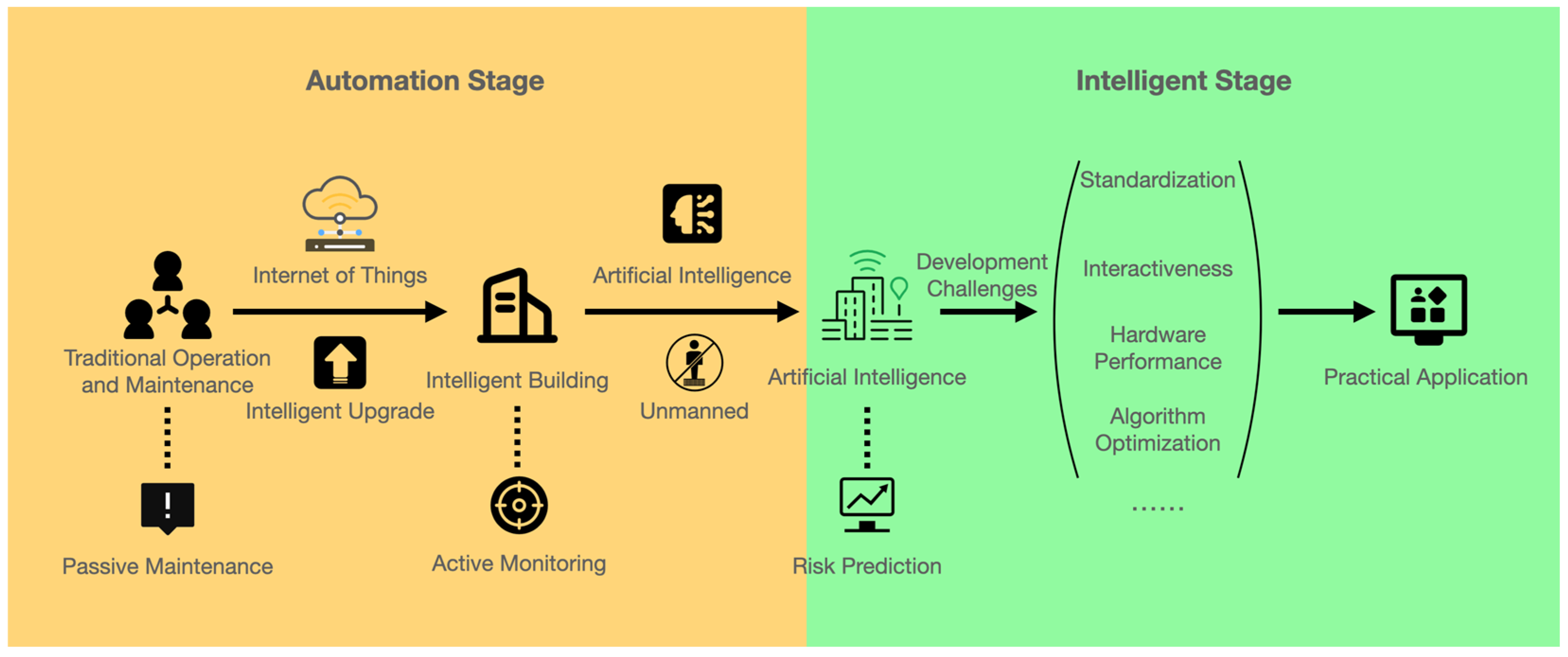

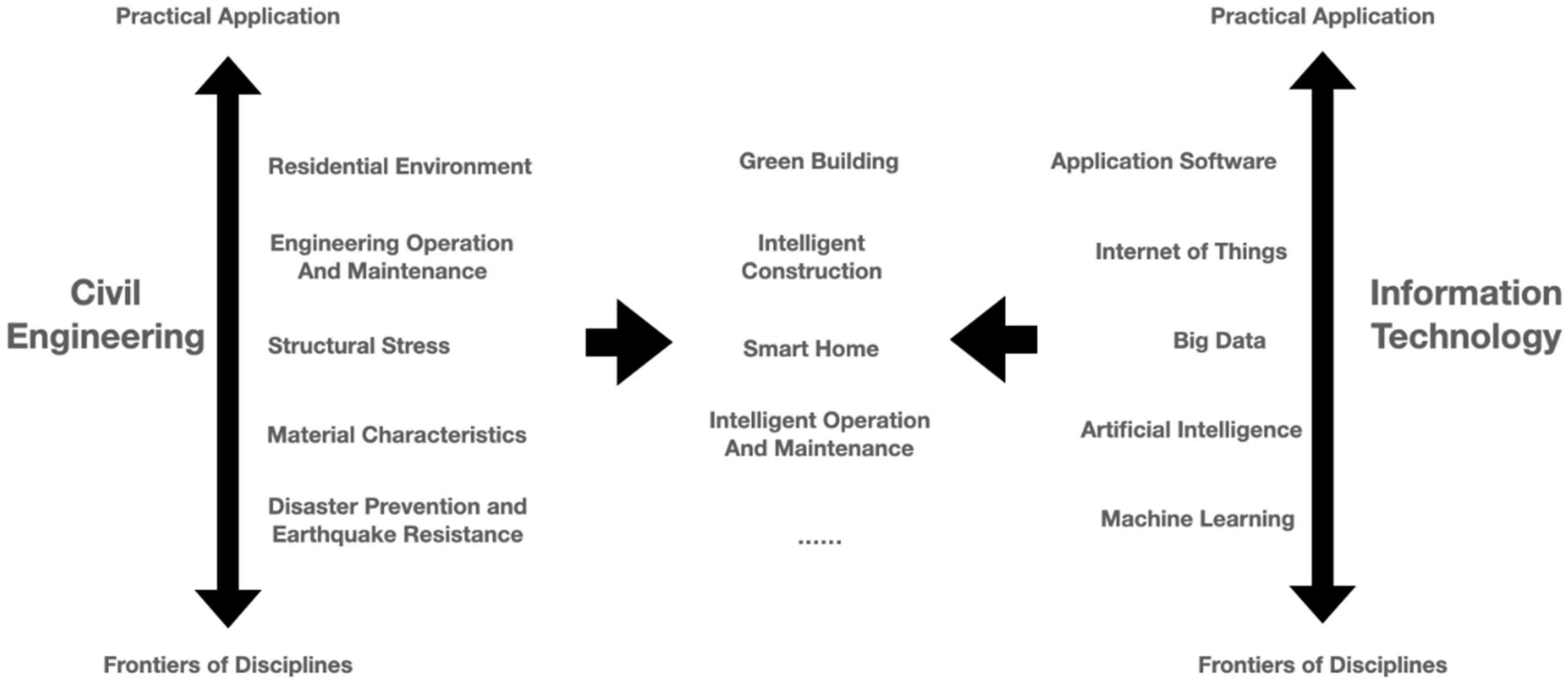
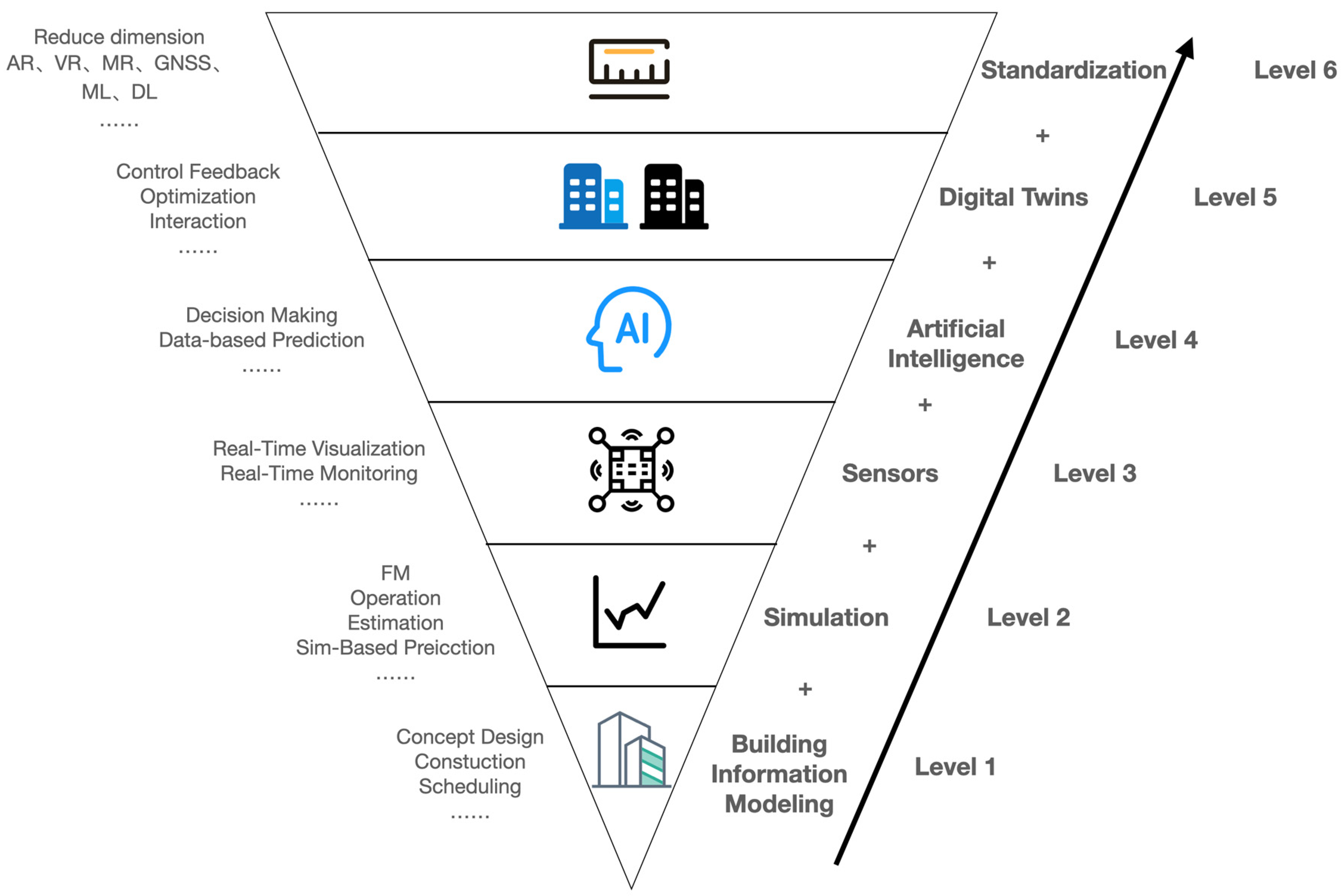
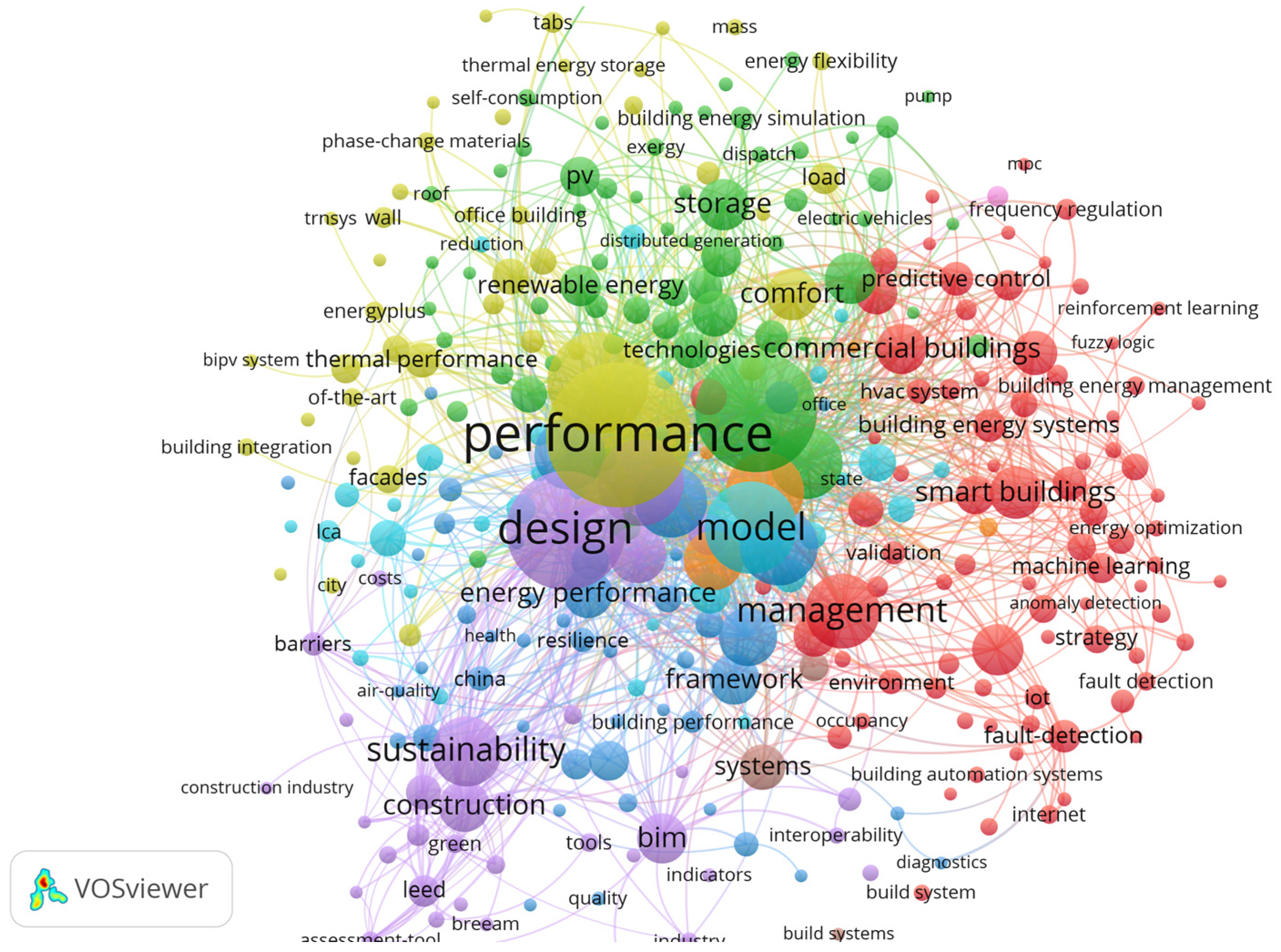
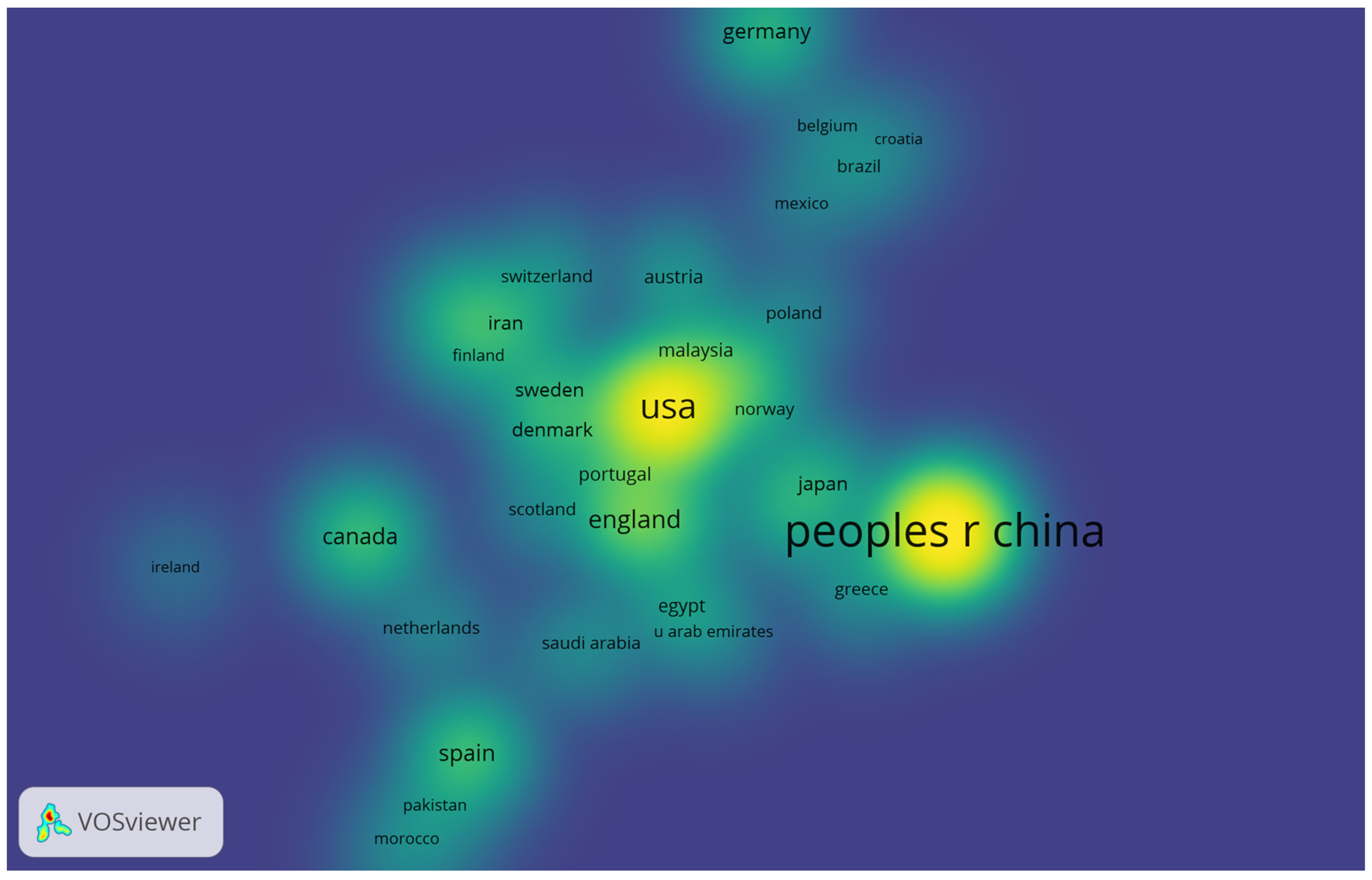
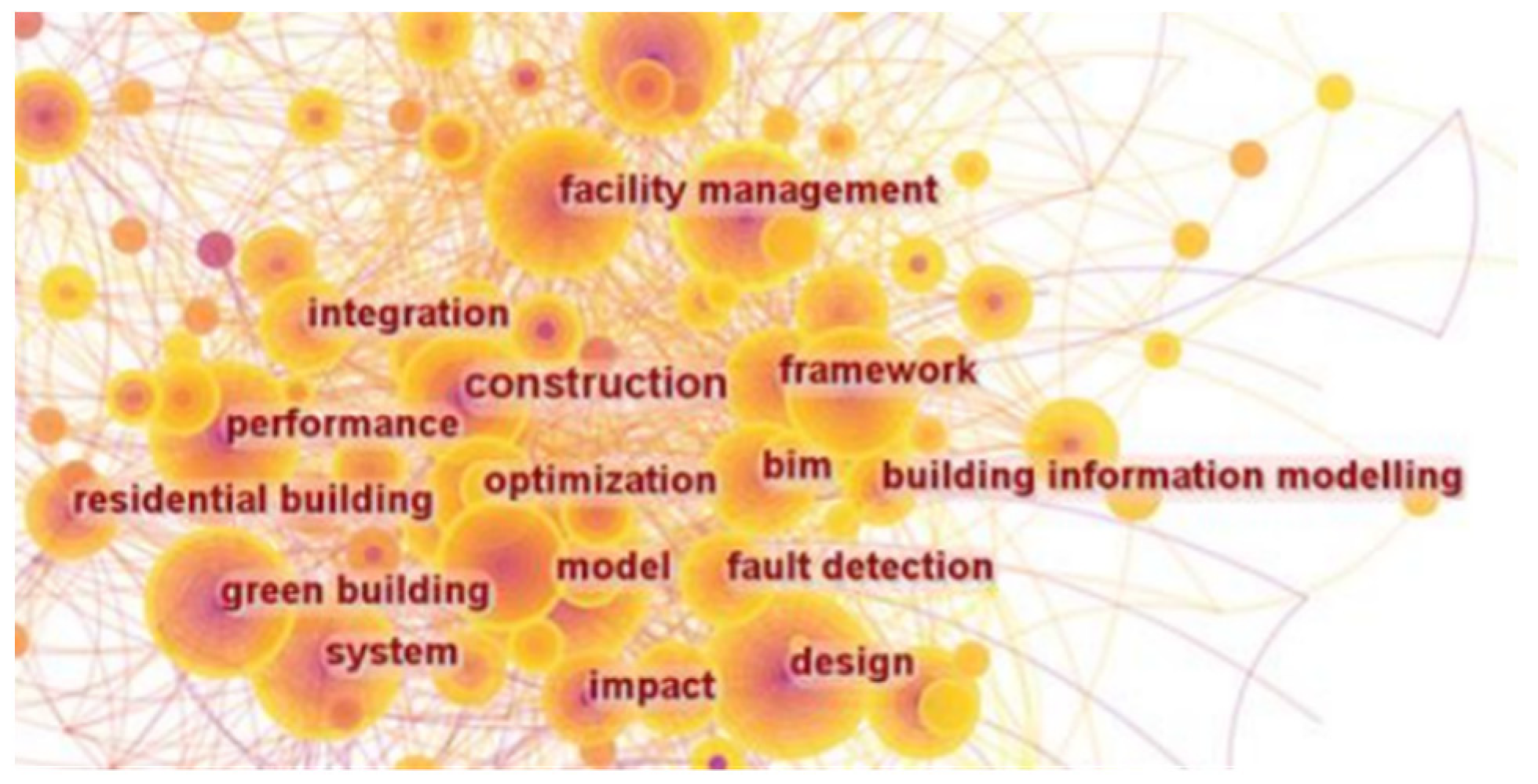
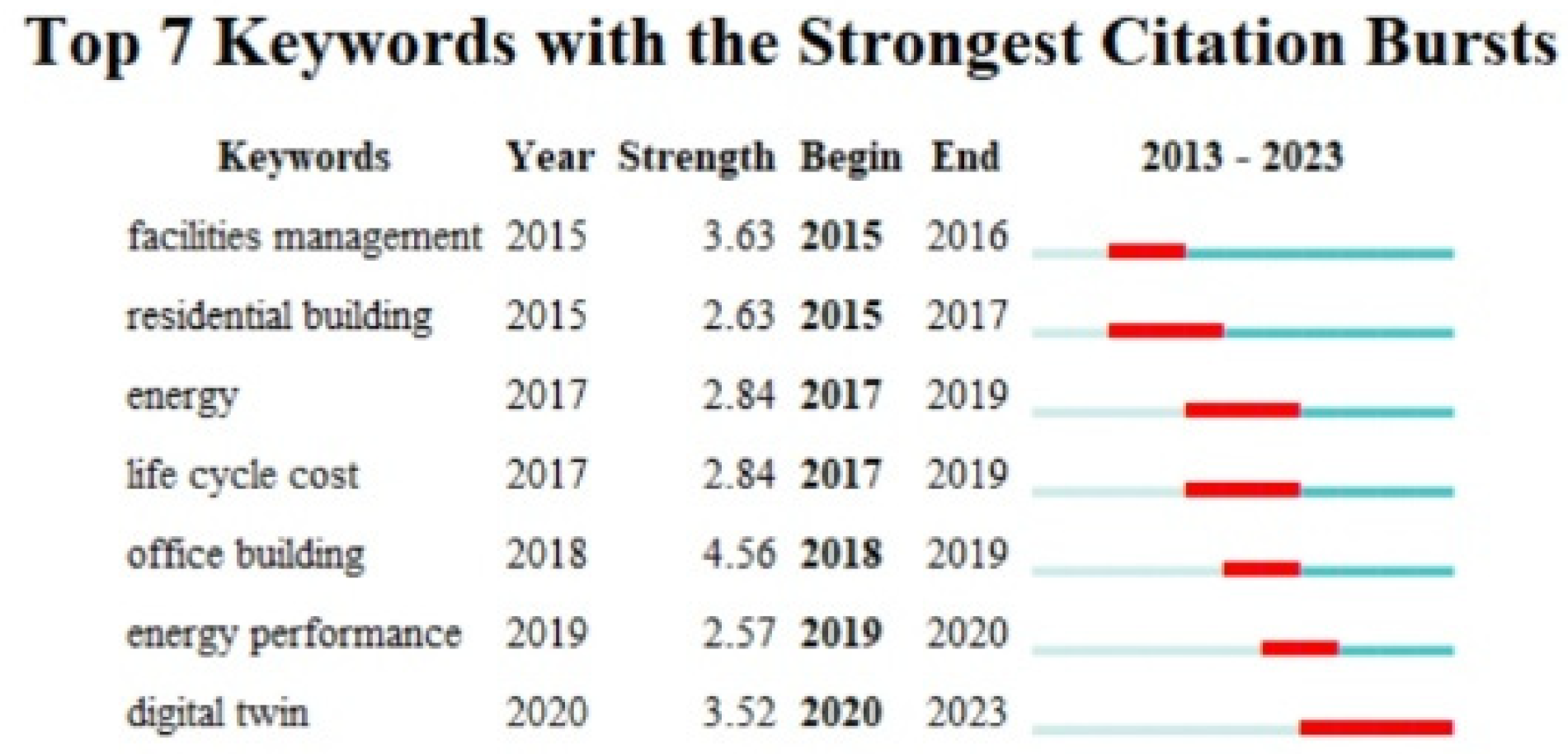
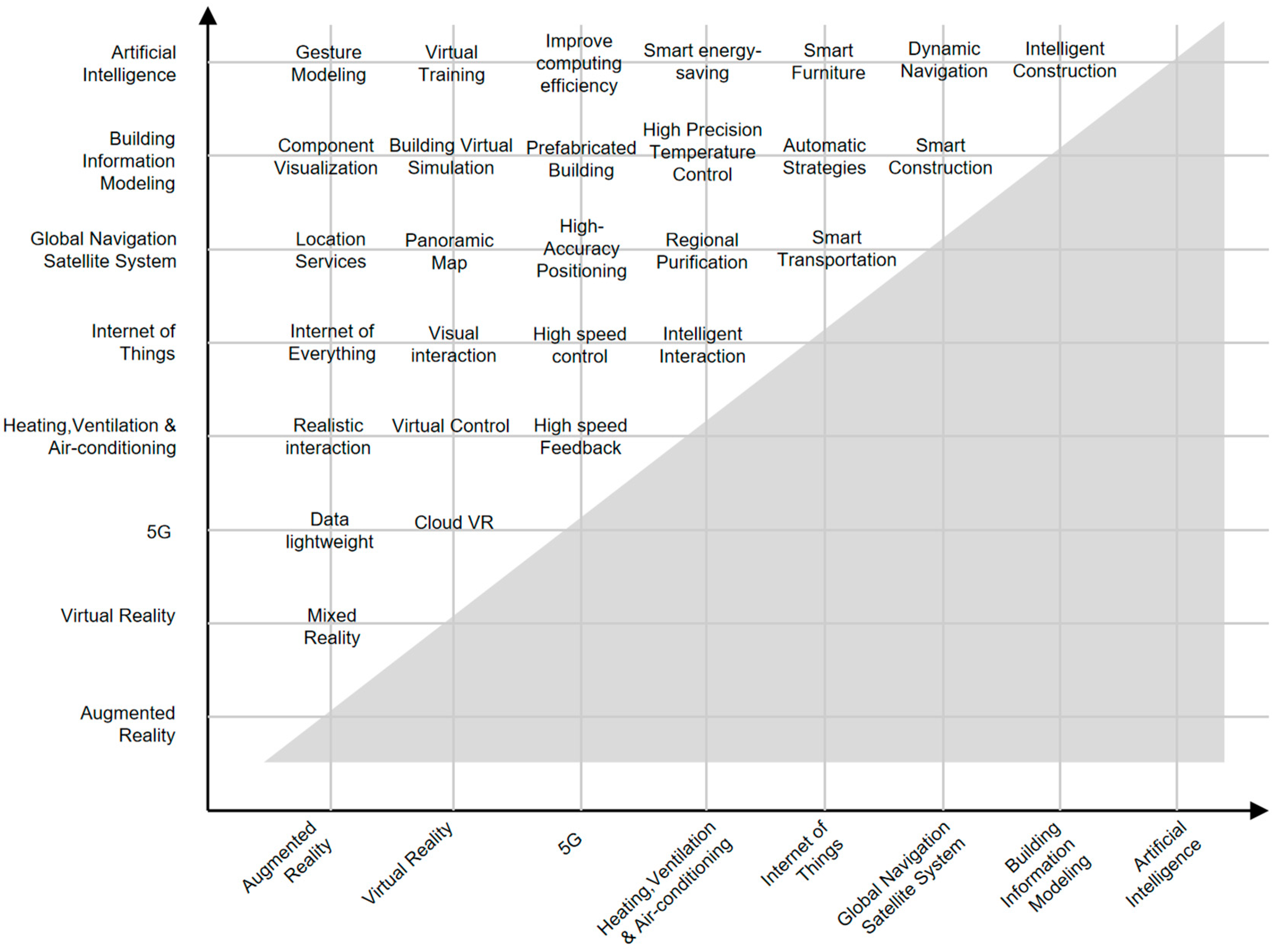


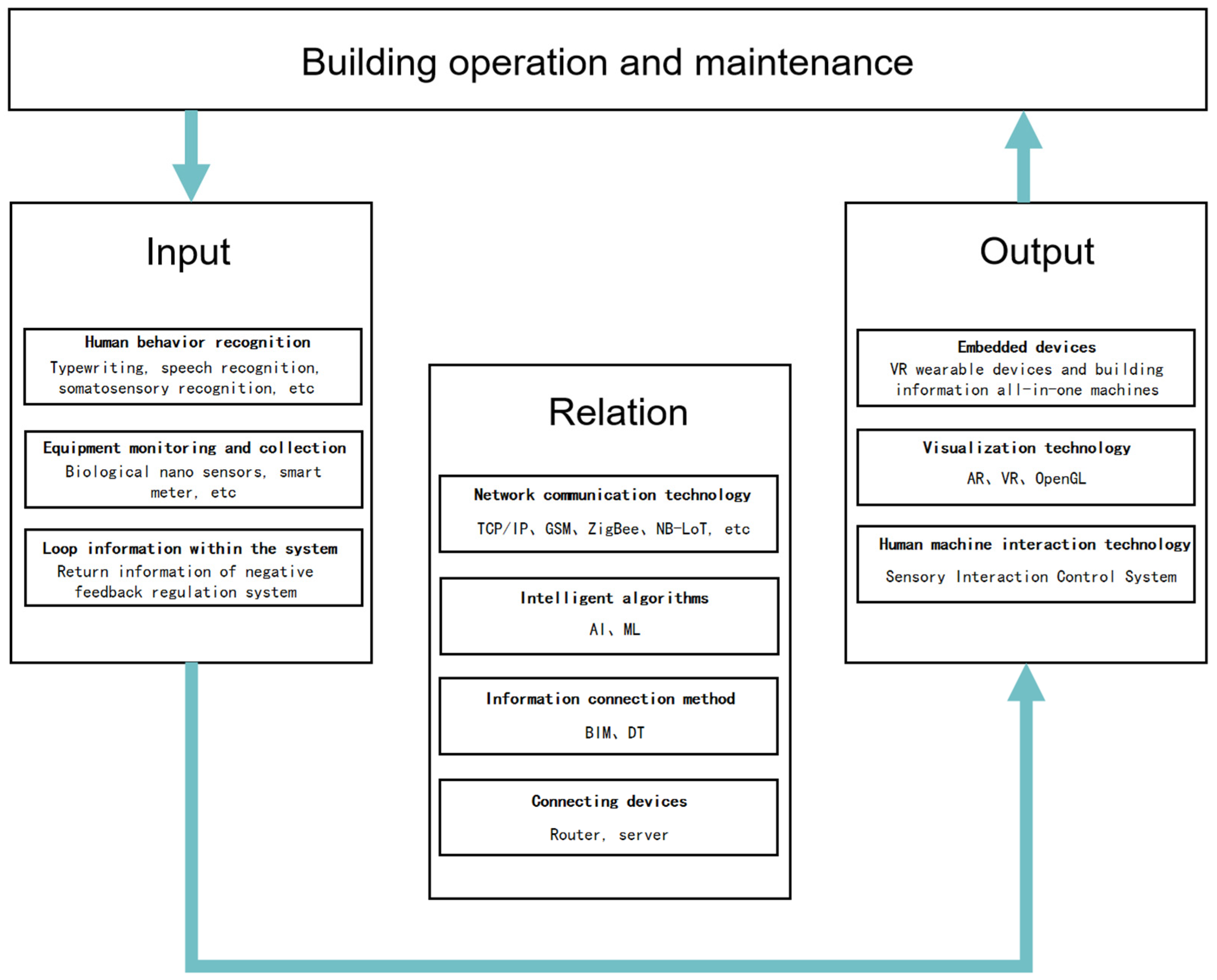

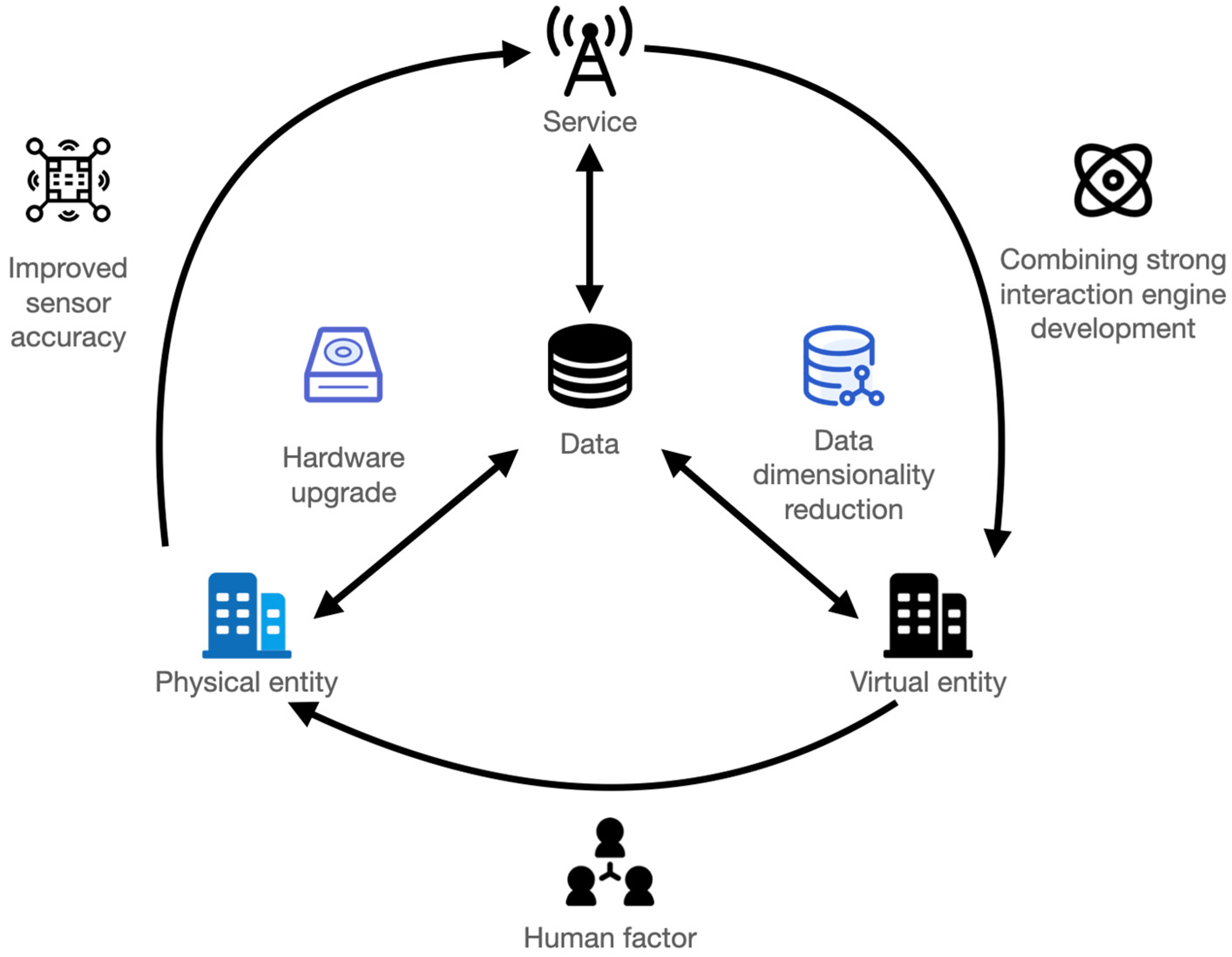
| Sort | Journal Title | Quantity |
|---|---|---|
| 1 | Sustainability | 3230 |
| 2 | Energies | 3020 |
| 3 | IEEE Access | 2813 |
| 4 | Construction and Building Materials | 2080 |
| 5 | Applied Sciences-Basel | 2039 |
| 6 | Sensors | 1850 |
| 7 | Proceedings of SPIE | 1698 |
| 8 | Journal of Building Engineering | 1684 |
| 9 | Energy and Buildings | 1674 |
| 10 | Building and Environment | 1451 |
| 11 | Lecture Notes in Computer Science | 1436 |
| 12 | Journal of Cleaner Production | 1264 |
| 13 | Applied Energy | 1250 |
| 14 | Energy | 1209 |
| 15 | Scientific Reports | 1168 |
| 16 | IOP Conference Series: Materials Science and Engineering | 937 |
| 17 | Buildings | 935 |
| 18 | IOP Conference Series: Earth and Environmental Science | 855 |
| 19 | International Journal of Environmental Research and Public Health | 846 |
| 20 | Remote Sensing | 821 |
| 21 | Engineering Structures | 810 |
| 22 | Science of The Total Environment | 764 |
| 23 | Renewable Energy | 752 |
| 24 | Journal of Physics: Conference Series | 749 |
| 25 | Applied Thermal Engineering | 724 |
Disclaimer/Publisher’s Note: The statements, opinions and data contained in all publications are solely those of the individual author(s) and contributor(s) and not of MDPI and/or the editor(s). MDPI and/or the editor(s) disclaim responsibility for any injury to people or property resulting from any ideas, methods, instructions or products referred to in the content. |
© 2023 by the authors. Licensee MDPI, Basel, Switzerland. This article is an open access article distributed under the terms and conditions of the Creative Commons Attribution (CC BY) license (https://creativecommons.org/licenses/by/4.0/).
Share and Cite
Jiao, Z.; Du, X.; Liu, Z.; Liu, L.; Sun, Z.; Shi, G.; Liu, R. A Review of Theory and Application Development of Intelligent Operation Methods for Large Public Buildings. Sustainability 2023, 15, 9680. https://doi.org/10.3390/su15129680
Jiao Z, Du X, Liu Z, Liu L, Sun Z, Shi G, Liu R. A Review of Theory and Application Development of Intelligent Operation Methods for Large Public Buildings. Sustainability. 2023; 15(12):9680. https://doi.org/10.3390/su15129680
Chicago/Turabian StyleJiao, Zedong, Xiuli Du, Zhansheng Liu, Liang Liu, Zhe Sun, Guoliang Shi, and Ruirui Liu. 2023. "A Review of Theory and Application Development of Intelligent Operation Methods for Large Public Buildings" Sustainability 15, no. 12: 9680. https://doi.org/10.3390/su15129680
APA StyleJiao, Z., Du, X., Liu, Z., Liu, L., Sun, Z., Shi, G., & Liu, R. (2023). A Review of Theory and Application Development of Intelligent Operation Methods for Large Public Buildings. Sustainability, 15(12), 9680. https://doi.org/10.3390/su15129680








